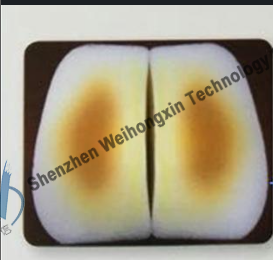Key Factors Behind Foam Production Burnt Core Issues: Causes and Solutions
In actual foam production, accidents and problems are indeed varied, particularly due to factors such as raw materials, formulation, environmental conditions, and storage. Below is a detailed analysis of the causes behind burnt core issues (where the reaction center temperature exceeds the raw material's antioxidant limit):
Polyether Polyol Quality Issues
Excess moisture: During production or storage/transportation, polyether polyol may absorb moisture, leading to excessive water content, which can affect the foaming reaction and cause localized overheating.
High levels of peroxides and low-boiling impurities: These impurities can participate in side reactions during foaming, leading to heat accumulation.
High concentration of metal ions: Metal ions can catalyze certain oxidation reactions, increasing heat within the system.
Improper antioxidant selection or concentration: The wrong type or concentration of antioxidant can fail to suppress oxidation reactions effectively, increasing the risk of overheating.
Formulation Issues
Excessive TDI index: When the TDI (toluene diisocyanate) is in excess, the rate of heat release during the reaction increases, causing a sharp rise in the reaction center temperature.
Improper ratio of foaming agents: An imbalance between water and physical blowing agents (e.g., Freon) may lead to more intense reactions and slower heat dissipation.
Insufficient physical blowing agent: Insufficient blowing agents can result in fewer bubbles forming during foaming, limiting heat distribution.
Excess water: Excess water can lead to overly vigorous reactions, generating too much heat.
Climatic Impact
High temperature and humidity: During summer, high ambient temperatures and humidity levels can slow down the dissipation of heat, causing the material temperature, especially at the reaction center, to exceed the antioxidant limit, leading to burnt core issues.
Improper Storage
Accumulated heat: If the TDI index is elevated during post-curing, residual heat buildup can increase the internal temperature. This is particularly problematic when materials are stacked, leading to poor internal heat dissipation and a higher risk of burnt cores.
These issues can be mitigated by optimizing raw material selection, adjusting formulation ratios, improving storage conditions, and controlling the production environment. Effective monitoring of the temperature and heat management during the foaming reaction is also crucial.
Ningbo Zhongyuan Pigment Co., Ltd. is a professional manufacturer of sponge foaming color paste , additives,anti-oxygen,anti-yellowing,gel powder etc in China. Its products are widely used in Flexible foam, Memory foam, Rigid foam,, Integral skin foam, Elastomer.



 Send Email
Send Email +8613715321452
+8613715321452